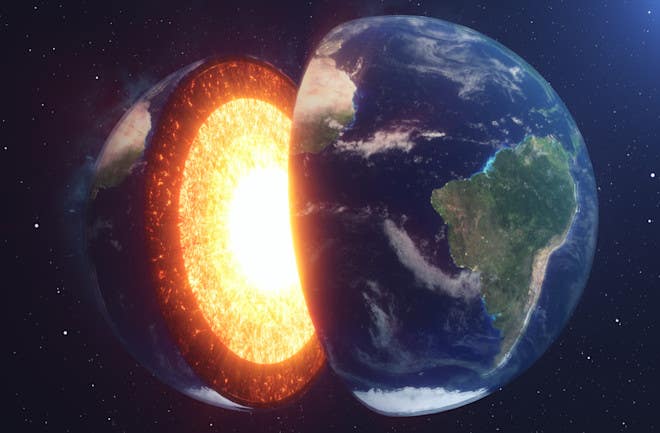Mount Everest is growing taller every day due to an unexpected geological force
Mount Everest’s summit isn’t solely the work of tectonic activity—its ongoing ascent is also driven by an unexpected geological force.

Rising to 8,849 meters (29,032 feet), Mount Everest—called Sagarmāthā in Nepali and Chomolungma in Tibetan—is the tallest mountain on Earth. (CREDIT: CC BY-SA 4.0)
Mount Everest’s towering height isn’t shaped by tectonic forces alone. Its continued growth owes a quiet debt to nearby rivers. These rivers, cutting through deep gorges, have helped lift the mountain skyward over the last 89,000 years.
A recent study in Nature Geoscience reveals a surprising partnership between flowing water and rising rock. As rivers like the Arun and Kosi chip away at the landscape, they set off a chain reaction that helps Everest climb even higher.
When massive amounts of rock are eroded and carried downstream, the ground beneath gets lighter. This triggers what's known as isostatic rebound—an upward flexing of the Earth’s crust in response to the lost weight.
Over time, that rebound adds up. Scientists from University College London (UCL) and the China University of Geosciences say the process has lifted Everest by as much as 50 meters. Though it only rises about two millimeters a year from this effect, that tiny push adds up over millennia.
“Mount Everest is a remarkable mountain of myth and legend, and it’s still growing,” said Adam Smith, a co-author of the study. “Our research shows that as the nearby river system cuts deeper, the loss of material is causing the mountain to spring further upwards.” This natural tug-of-war between erosion and uplift is reshaping the region in ways that are still being uncovered.
Towering at 8,849 meters, Everest stands as the tallest point on Earth, dwarfing nearby giants. Its sheer height and steep flanks make it a striking feature of the landscape. While climbers have long been drawn to its extremes, scientists are just as captivated by the hidden forces pushing it even higher.
Part of that rise comes from deep river valleys carving through the terrain. As they cut down, the crust responds by lifting. This process, known as isostatic rebound, has added between 15 to 50 meters to the mountain's height over time. Though the growth is slow—just two millimeters a year—it adds up across centuries.
Related Stories
The key to understanding this uplift lies in the concept of isostatic rebound, a geological process where the Earth’s crust rises in response to the removal of surface weight. Dr. Matthew Fox, another co-author from UCL Earth Sciences, explained that Everest and its neighboring peaks are rising faster than they are eroding. He stated, “We can see them growing by about two millimeters a year using GPS instruments, and now we have a better understanding of what’s driving it.”
The Arun river, which flows east of Everest, has long been shaping the landscape through its erosion. About 89,000 years ago, it merged with the Kosi river system in a process called drainage piracy. This merger amplified the river’s erosive power, further deepening the gorge and eroding more material.
With less weight pushing down on the crust, the uplift rate of Everest and nearby peaks increased. Lead author Dr. Xu Han of the China University of Geosciences explained, “The changing height of Mount Everest really highlights the dynamic nature of the Earth’s surface. The interaction between the erosion of the Arun river and the upward pressure of the Earth’s mantle gives Mount Everest a boost, pushing it up higher than it would otherwise be.”
The uplift phenomenon isn’t limited to Mount Everest alone. Neighboring peaks, including Lhotse and Makalu—respectively the fourth and fifth highest mountains in the world—are also being affected by the same forces. Makalu, being closer to the Arun river, experiences a slightly higher uplift rate compared to Everest and Lhotse.
Dr. Jin-Gen Dai of the China University of Geosciences noted the uniqueness of the regional river system, describing how the Arun flows at high altitude before joining the Kosi river, which descends steeply. This topographical feature, indicative of an unsteady state, likely plays a key role in the height difference between Everest and the other peaks.
The study’s findings highlight the ongoing growth of Everest, even as erosion continues to reshape the surrounding landscape. GPS data has shown that uplift currently outpaces erosion in the region, meaning Everest's height is still increasing despite natural forces that try to wear it down.
Dai likened isostatic rebound to a boat rising in water when weight is removed. When masses like ice or eroded rock are taken away, the underlying land rises. This process is common in other parts of the world as well, such as Scandinavia, where the land still rises in response to the melting of thick ice sheets from the last Ice Age.
This geological resilience underscores the dynamic nature of Earth's crust, constantly adapting to changes in pressure and weight. Dr. Dai pointed out that while Mount Everest might seem like an immutable feature of the landscape, it is actually subject to continuous geological forces, reminding us that Earth's surface is in perpetual flux.
The birth of the Himalayas dates back roughly 50 million years, arising from the collision between the Indian subcontinent and Eurasia. The ongoing tectonic convergence has been pushing the Himalayas upwards ever since.
However, the researchers argue that isostatic rebound caused by the rivers significantly amplifies this uplift, adding another layer of complexity to Everest’s growth story. The erosion caused by the Arun and Kosi rivers doesn't just shape the valley floors but impacts the height of the tallest peaks, contributing to a remarkable geological narrative that continues today.
The interaction between rivers and mountains is an example of how forces that seem opposed—erosion and uplift—can work in tandem to shape Earth's most extreme landscapes. As the rivers carve away the valleys, the mountains continue to rise in response, their heights adjusting to the changing distribution of mass. This complex relationship between erosion and uplift is what keeps Mount Everest growing. Adam Smith noted that as erosion proceeds, the rate of uplift from isostatic rebound could even increase in the future.
Cultural significance also enriches Everest’s physical stature. The mountain is sacred to the local Sherpa and Tibetan communities and stands as a symbol of human endurance and achievement. "Mount Everest occupies a unique place in human consciousness," said Dai. "Physically, it represents Earth's highest point, giving it immense significance simply by virtue of its stature. Culturally, it symbolizes the ultimate challenge, embodying human endurance and our drive to surpass perceived limits."
Mount Everest’s growth, influenced by both tectonic forces and river-induced uplift, reflects a dynamic process that is both ancient and ongoing. It serves as a reminder that even seemingly unchanging landmarks are part of Earth's constantly evolving landscape.
This continuous interaction between geological forces keeps reshaping our world, offering insights into how the most iconic mountains came to be—and how they keep changing. Everest, still reaching higher into the sky, embodies not just a peak of stone but a symbol of the relentless forces shaping our planet.
Note: Materials provided above by The Brighter Side of News. Content may be edited for style and length.
Like these kind of feel good stories? Get The Brighter Side of News' newsletter.
Joshua Shavit
Science & Technology Writer | AI and Robotics Reporter
Joshua Shavit is a Los Angeles-based science and technology writer with a passion for exploring the breakthroughs shaping the future. As a contributor to The Brighter Side of News, he focuses on positive and transformative advancements in AI, technology, physics, engineering, robotics and space science. Joshua is currently working towards a Bachelor of Science in Business Administration at the University of California, Berkeley. He combines his academic background with a talent for storytelling, making complex scientific discoveries engaging and accessible. His work highlights the innovators behind the ideas, bringing readers closer to the people driving progress.



